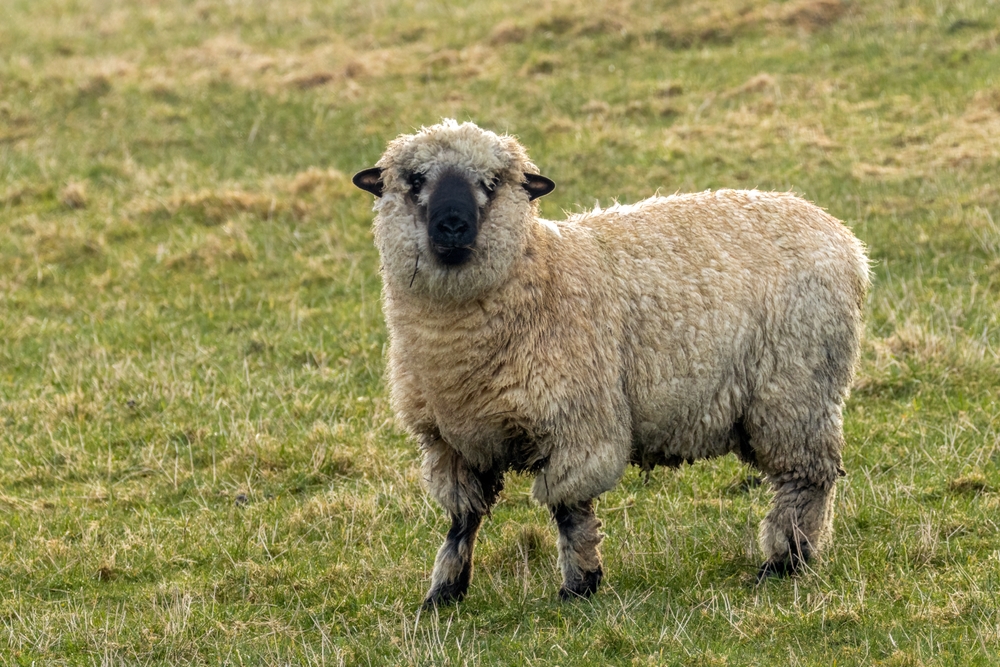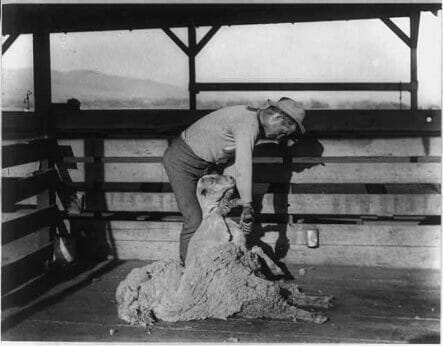Digging In: Why Don’t Americans Eat Mutton?
The idea of mutton leaves a bad taste for many US consumers—most of whom have never even tried it.
Digging In: Why Don’t Americans Eat Mutton?
The idea of mutton leaves a bad taste for many US consumers—most of whom have never even tried it.

Shropshire sheep are raised primarily for their meat.by Shutterstock.
“Why can we only get lamb in the US, as opposed to mutton?”
That’s what Bobbie Kramer, a veterinarian near Portland, Oregon, was wondering when she responded to our recent call for reader questions about where their food comes from.
“As a meat eater, I enjoy the flavor and texture of lamb. But I’d love to try mutton. I know that in other parts of the world, lamb and mutton are more economical and popular to raise than cattle,” she writes. “I’ve traveled a fair bit (Australia, New Zealand, Europe and Great Britain) and have friends from parts of the world where small ruminants such as sheep and goats are raised for meat and fiber. My good friend from South Africa tells me how she and her husband miss cooking with mutton, which they find more flavorful and satisfying than lamb. What happens to the mutton-aged sheep here?”
It’s true that it’s difficult, if not impossible, to find mutton—defined as meat from a sheep over two years old—in American grocery stores. “Mutton is not an accessible protein option in the US,” says Megan Wortman, executive director of the American Lamb Board, an industry group aimed at expanding the market for domestic sheep products. If you’re looking to get your hands on some mutton, “you’d have to go through a specialty butcher shop or directly to a special-order processor,” she says.
Mutton has less tender flesh and a stronger flavor than lamb, which comes from sheep that are less than a year old. (Meat from sheep aged one to two years is generally called “yearling” in the US, and “hogget” elsewhere around the world.) That stronger flavor lends itself to curries, stews and “value-added” products such as spiced sausages, says Wortman, “so most of our mutton goes into value-added products or into specialty ethnic markets at this point.”
Some mutton is exported to Mexico, where it’s braised low and slow, barbacoa-style. Mutton is also often sold at butcher shops that serve communities that have brought a taste for the meat with them from elsewhere, such as new immigrants from Africa, Central America and the Middle East. (Wortman notes that the majority of US lamb and mutton is halal processed.) And in western Kentucky, a tradition of barbecued mutton still holds, although no one is quite sure why.
“There are consumer segments that would raise their hand and say ‘yes, I would prefer a stronger flavor,’ but we just don’t market it in mainstream grocery stories,” says Wortman. “There’s definitely a general hesitation that the minute you label it ‘mutton’ the average consumer has negative connotations with that product.”
So, how did mutton, a widely consumed protein around the world, come to be unmarketable to most Americans?
Sheep were first brought to the southwestern US by Spanish conquistadors in the 16th century, and flocks grew with the influx of European settlers, who utilized sheep locally for their wool and meat. With rising demand for wool in the 19th century, sheep farming became more industrialized, but the primary focus was on the wool, not the meat. Simply put, mutton was a byproduct of wool production.
Mutton was slaughtered, sold and canned locally, but no large-scale infrastructure arose to source and process sheep meat. “The simplest story is that no commercial meat industry developed around mutton,” says Roger Horowitz, a historian and author of Putting Meat on the American Table. “It seems to me that it was very rural in character.” He points to a can of roast mutton in his collection, dating from the 1890s, as emblematic of the time: It advertised that its contents were both slaughtered and canned “on the range” in Fort McKavett, Texas.

That’s not to say that mutton wasn’t consumed at the dinner table. Mutton chops were featured in cookbooks and restaurant menus from the late 19th and early 20th century, as the population grew and urbanized and demand for protein rose. Lamb was a seasonal product served at Christmas, and for a time, sheep meat was seen as a food for the upper classes. Even first-class passengers on the RMS Titanic were served grilled mutton—for luncheon and breakfast.
Sheep numbers in the US peaked in 1884 at 51 million head. But with the advent of synthetic fibers in the 20th century, wool production began to flag, and sheep numbers—and the availability of mutton—declined. (In 2016, there were five million head of sheep in the US.) Lamb consumption began to dwindle, too: Americans consumed five pounds of lamb per person in 1912. Today, that number is about a pound per person annually.
Pork, Horowitz notes, was more convenient. “Everybody had pigs, and pigs are a lot better to raise for meat because they eat anything.” And when it came to grazing animals, cows just made more sense: They provide far more meat per animal, and demand for beef was—and remains—high.

By the end of World War II, mutton had come to symbolize everything that Americans wanted to leave behind. Men returned from the war swearing they’d never eat another bite of mutton after stomaching tinned army rations that included the notoriously unappetizing “Mutton Stew with Vegetables.” Women were enjoying new appliances that allowed them a modicum of freedom from household chores. Modernity and convenience were all the rage, and mutton, which requires dry aging and long, slow cooking times to become tender, was neither modern nor convenient. If mutton ever really had a heyday, by midcentury, it was over.
“I joke sometimes that I do lamb by day and sheep by night,” says Cody Heimke, who, in addition to managing the Niman Ranch lamb program, raises a heritage breed of Shropshire sheep on his property in south central Wisconsin. The flock of about 50 head are raised primarily for breeding, but Shropshires were at one time the most popular sheep in the world, primarily because of the quality of their mutton. “[The] breed of sheep doesn’t really matter when it comes to the flavor of lamb, but it does when it comes to the taste of mutton,” he says.
Heimke does “a little bit” of direct lamb and mutton sales when he has sheep to harvest, selling middle cuts to a restaurant in Madison, and utilizing the rest for sausages in varieties such as Bavarian-style, Merguez and spicy Berbere. He acknowledges that there isn’t a lot of demand for mutton. “I got a call this year, somebody looking for mutton, which is rare. I don’t usually get those calls.”
His advice for would-be mutton eaters? “Find somebody at a local farmers market that’s selling lamb. You really gotta find somebody that’s raising sheep and doing direct marketing, and ask them if they’re doing any mutton.”
For his part, Heimke says he enjoys mutton in sausage form. Last year, one of his wholesale clients was looking for ground lamb, but he didn’t have any in stock. “I’m like, ‘Well, what about ground mutton?’ And we [sold] one-pounders of ground mutton,” he says. “I tasted that before I sold any of it, and it was as good or better than any ground lamb I’ve ever had.”
Have you ever eaten mutton? Do you want to try mutton—or not? Tell us what you think in the comments below.
Thanks to Bobbie Kramer for submitting her question for our “Digging In” series. Got a question about where your food comes from? Let us know what you’d like us to investigate next by filling out this form.
Follow us

This work is licensed under a Creative Commons Attribution-NoDerivatives 4.0 International License.
Want to republish a Modern Farmer story?
We are happy for Modern Farmer stories to be shared, and encourage you to republish our articles for your audience. When doing so, we ask that you follow these guidelines:
Please credit us and our writers
For the author byline, please use “Author Name, Modern Farmer.” At the top of our stories, if on the web, please include this text and link: “This story was originally published by Modern Farmer.”
Please make sure to include a link back to either our home page or the article URL.
At the bottom of the story, please include the following text:
“Modern Farmer is a nonprofit initiative dedicated to raising awareness and catalyzing action at the intersection of food, agriculture, and society. Read more at <link>Modern Farmer</link>.”
Use our widget
We’d like to be able to track our stories, so we ask that if you republish our content, you do so using our widget (located on the left hand side of the article). The HTML code has a built-in tracker that tells us the data and domain where the story was published, as well as view counts.
Check the image requirements
It’s your responsibility to confirm you're licensed to republish images in our articles. Some images, such as those from commercial providers, don't allow their images to be republished without permission or payment. Copyright terms are generally listed in the image caption and attribution. You are welcome to omit our images or substitute with your own. Charts and interactive graphics follow the same rules.
Don’t change too much. Or, ask us first.
Articles must be republished in their entirety. It’s okay to change references to time (“today” to “yesterday”) or location (“Iowa City, IA” to “here”). But please keep everything else the same.
If you feel strongly that a more material edit needs to be made, get in touch with us at [email protected]. We’re happy to discuss it with the original author, but we must have prior approval for changes before publication.
Special cases
Extracts. You may run the first few lines or paragraphs of the article and then say: “Read the full article at Modern Farmer” with a link back to the original article.
Quotes. You may quote authors provided you include a link back to the article URL.
Translations. These require writer approval. To inquire about translation of a Modern Farmer article, contact us at [email protected]
Signed consent / copyright release forms. These are not required, provided you are following these guidelines.
Print. Articles can be republished in print under these same rules, with the exception that you do not need to include the links.
Tag us
When sharing the story on social media, please tag us using the following: - Twitter (@ModFarm) - Facebook (@ModernFarmerMedia) - Instagram (@modfarm)
Use our content respectfully
Modern Farmer is a nonprofit and as such we share our content for free and in good faith in order to reach new audiences. Respectfully,
No selling ads against our stories. It’s okay to put our stories on pages with ads.
Don’t republish our material wholesale, or automatically; you need to select stories to be republished individually.
You have no rights to sell, license, syndicate, or otherwise represent yourself as the authorized owner of our material to any third parties. This means that you cannot actively publish or submit our work for syndication to third party platforms or apps like Apple News or Google News. We understand that publishers cannot fully control when certain third parties automatically summarize or crawl content from publishers’ own sites.
Keep in touch
We want to hear from you if you love Modern Farmer content, have a collaboration idea, or anything else to share. As a nonprofit outlet, we work in service of our community and are always open to comments, feedback, and ideas. Contact us at [email protected].by Rose Garrett, Modern Farmer
September 21, 2023
Modern Farmer Weekly
Solutions Hub
Innovations, ideas and inspiration. Actionable solutions for a resilient food system.
ExploreShare With Us
We want to hear from Modern Farmer readers who have thoughtful commentary, actionable solutions, or helpful ideas to share.
SubmitNecessary cookies are absolutely essential for the website to function properly. This category only includes cookies that ensures basic functionalities and security features of the website. These cookies do not store any personal information.
Any cookies that may not be particularly necessary for the website to function and are used specifically to collect user personal data via analytics, ads, other embedded contents are termed as non-necessary cookies.
Mutton is common in western Kentucky.
My butcher once told me that in NY the law said he can sell lamb or mutton, but not both in the same shop, the reason being that you might substitute mutton for more expensive lamb (or was it the opposite?) I often see mutton on Indian and Pakistani menus, but I assume it’s just lamb. Those curries are so highly spiced it would be hard to tell the difference
Mexican barbacoa, made with mutton, is one of my favorite meals. Incredible. In Scotland they take sheep VERY seriously. At the big farmer’s market in Edinburgh, they sell lamb, hogget, and mutton. My favorite is hogget, which is sheep older than lamb and younger than mutton. In other words, between one and two years old.
We’re eating ground mutton every month here in Maine; sold at a local organic farm, which also sells different cuts of lamb. Can’t beat a mutton ragu with pappardelle noodles, especially into the colder months.
Having raised sheep, a big issue with American palates is that for some reason they are allergic to flavor and older wool sheep definitely have more funk in the flavor department however hair sheep are much more mild in flavor due to the lack of lanolin so a hair mutton is going to be the same level of funky flavor as a wool lamb i.e. not as much. The flavor really depends on the cut as well, mutton chops are amazingly good to my taste and are superior to lamb chops. Mutton leg has a stronger flavor and is more… Read more »
One of the biggest problems with sheep and other meat-producing-livestock here in New Mexico is the lack of slaughter-houses. If I understand correctly sheep have to be transported to California for slaughter – which is a thousand mile journey.
I was raised between France and N Africa and mutton was preferred over lamb except for grilled dishes
I have fond memories of mutton liver and lamb kidneys grilled on a skewer
I am opening a field to fork event space at our 15th st urban farm in St Petersburg FL
We shall be serving mutton dishes and intend to show guests what they have been missing
In India lamb and mutton are often same for consumers. Second one is more preferred.
I bought a lamb early this year from a livestock owner that also raises various fowl, goats and heritage pigs
I Have considered contacting her about mutton, since the lamb was only 35 pounds (vs the 1K pound steer also in my freezers) and I imagine that a bigger animal would also taste as good. My cooking Forte is slow cooking anyway. Thanks for the article to remind me to order a sheep next time.
heheh, surprised no one has mentioned this…the LARGEST hurdle to selling more mutton is the name “mutton”. Talk about a product desperately in need of new branding, this is it. It sounds like the nasty meat sailors and prisoners were forced to endure… Having said that, a finishing feed to smooth out what I imagine would be the iron-like notes from the meat (I assume it has the same iron-notes as grass-fed beef) would be a good step to try and get to a consumer-friendly taste profile. But, most important step is to figure way to re-brand or get the… Read more »